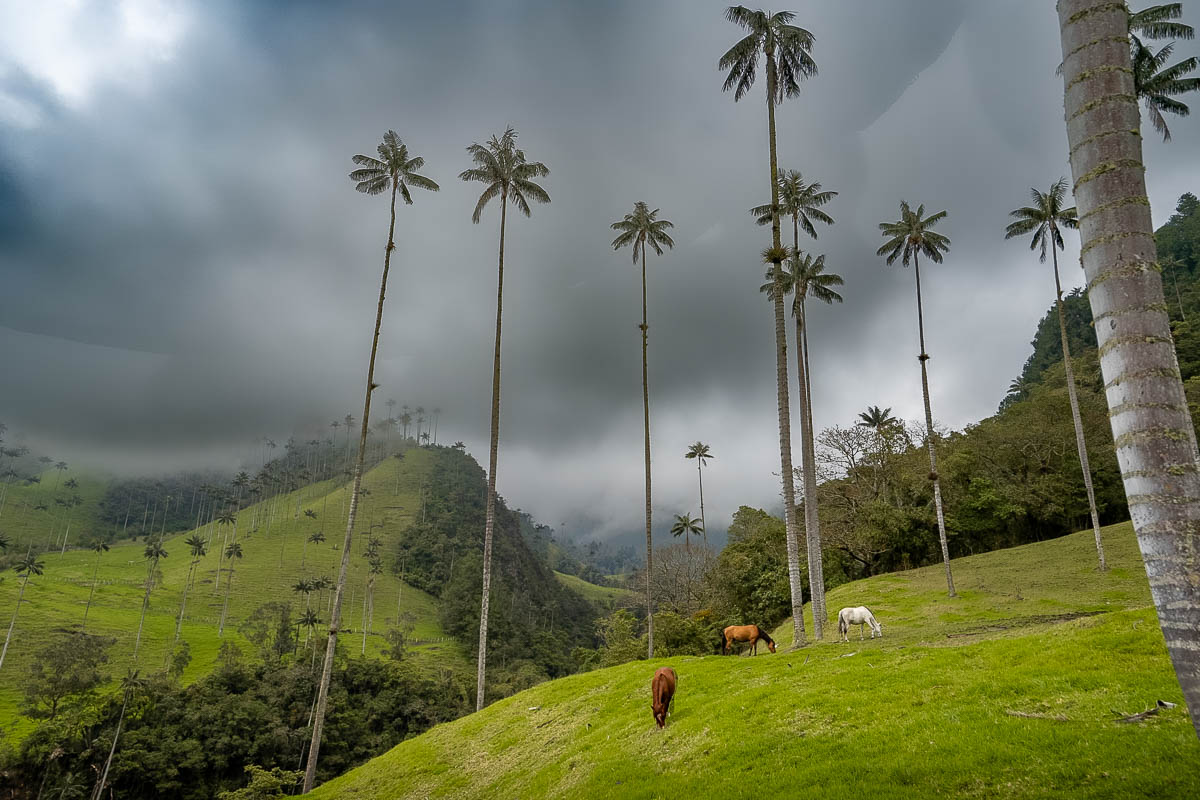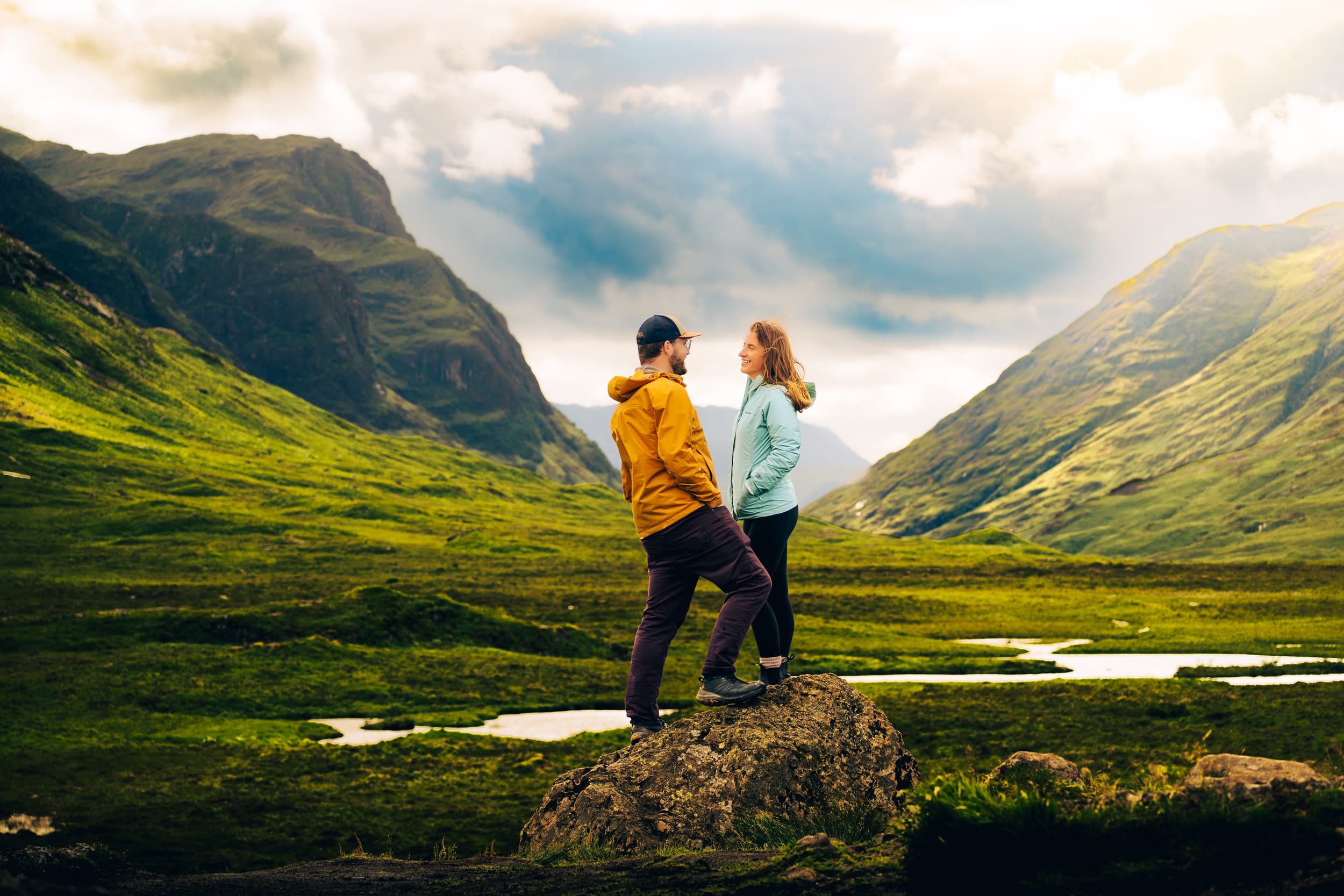The Cocora Valley is one of the most popular stops in Colombia—and for good reason! The Valley is known for its lush green hills, low-hanging clouds, and wax palm trees, which are actually the tallest palm trees on the planet. And one of the coolest things about the Cocora Valley is that you can actually explore it on your own two feet, wandering under palm trees towering up to 200 feet overhead. So if you want to experience this magical corner of the planet for yourself, here’s everything you need to know about the Cocora Valley hike.
This post may contain affiliate links. If you make a purchase through them, we may receive a small commission, for which we are extremely grateful, at no extra cost to you.
About the Cocora Valley
The Cocora Valley is located near the colorful town of Salento in the Quindio province, high in the Andes of Colombia’s Coffee Triangle. This area has an absolutely beautiful landscape, with cows and horses dotting the hillsides of green pastures and tropical birds flitting through its cloud forests—but most people come here to see its famed wax palms.
Wax palms are pretty special. Besides looking like something straight out of Dr. Seuss, with a long skinny trunk and an enormous floof at the top, they’re also endangered and only found in Colombia and northern parts of Peru. And the Cocora Valley just so happens to have one of the highest concentrations of wax palms in the world!
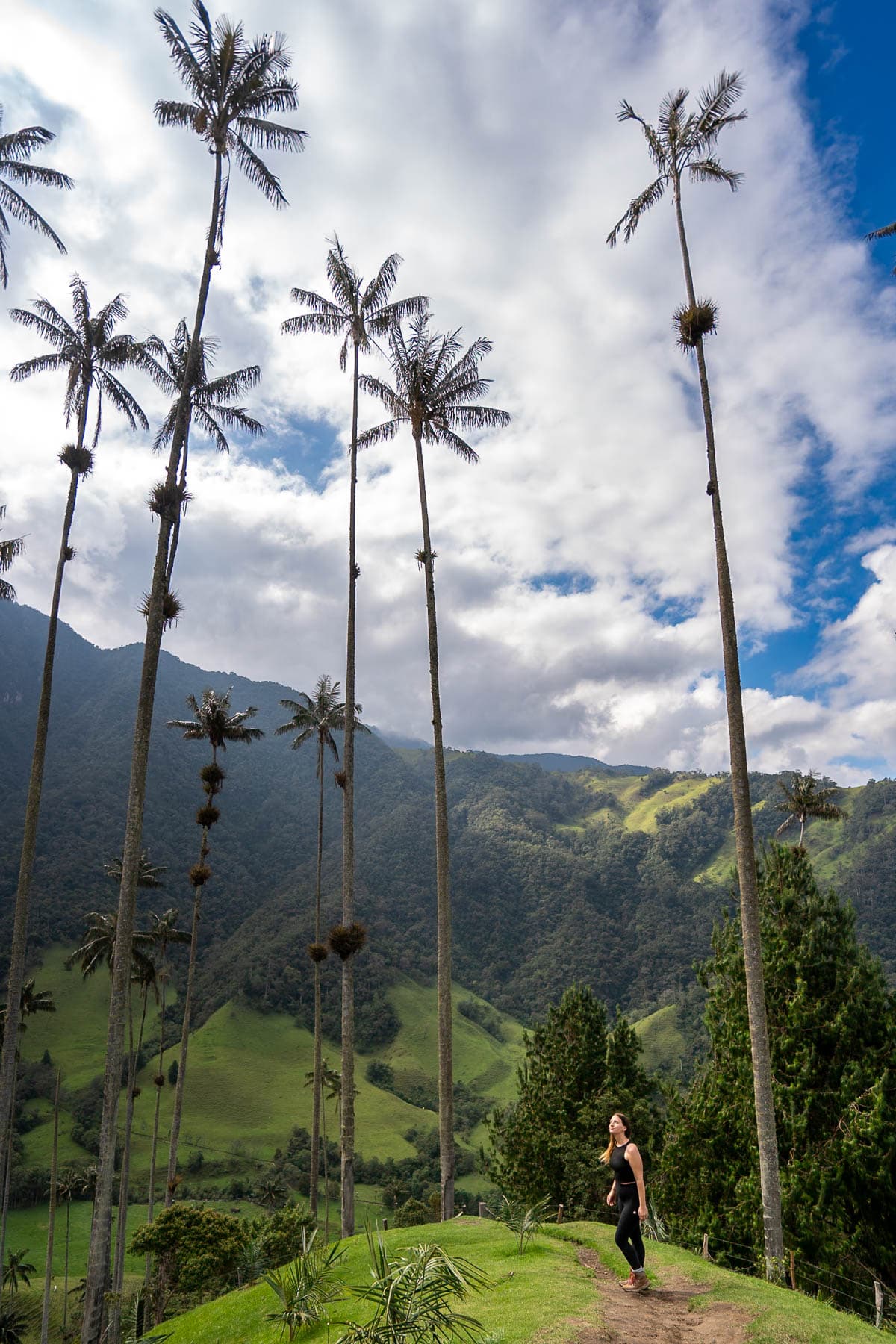
About the Cocora Valley Hike
Before visiting the Cocora Valley, I thought there was really only one hike through the Cocora Valley.
So when my husband, Justin, and I showed up and discovered there were actually three different trails you can choose to hike here, we were a bit confused—and, actually, accidentally made the wrong choice amongst them.
Essentially, there’s one main route, called the Cocora Valley hike. You can either hike the northwestern portion as a shorter out-and-back trail through El Bosque de Las Palmas (the wax palm tree forest), or you can hike the entire trail as a longer loop, which goes through the wax palms, farmland, and cloud forests.
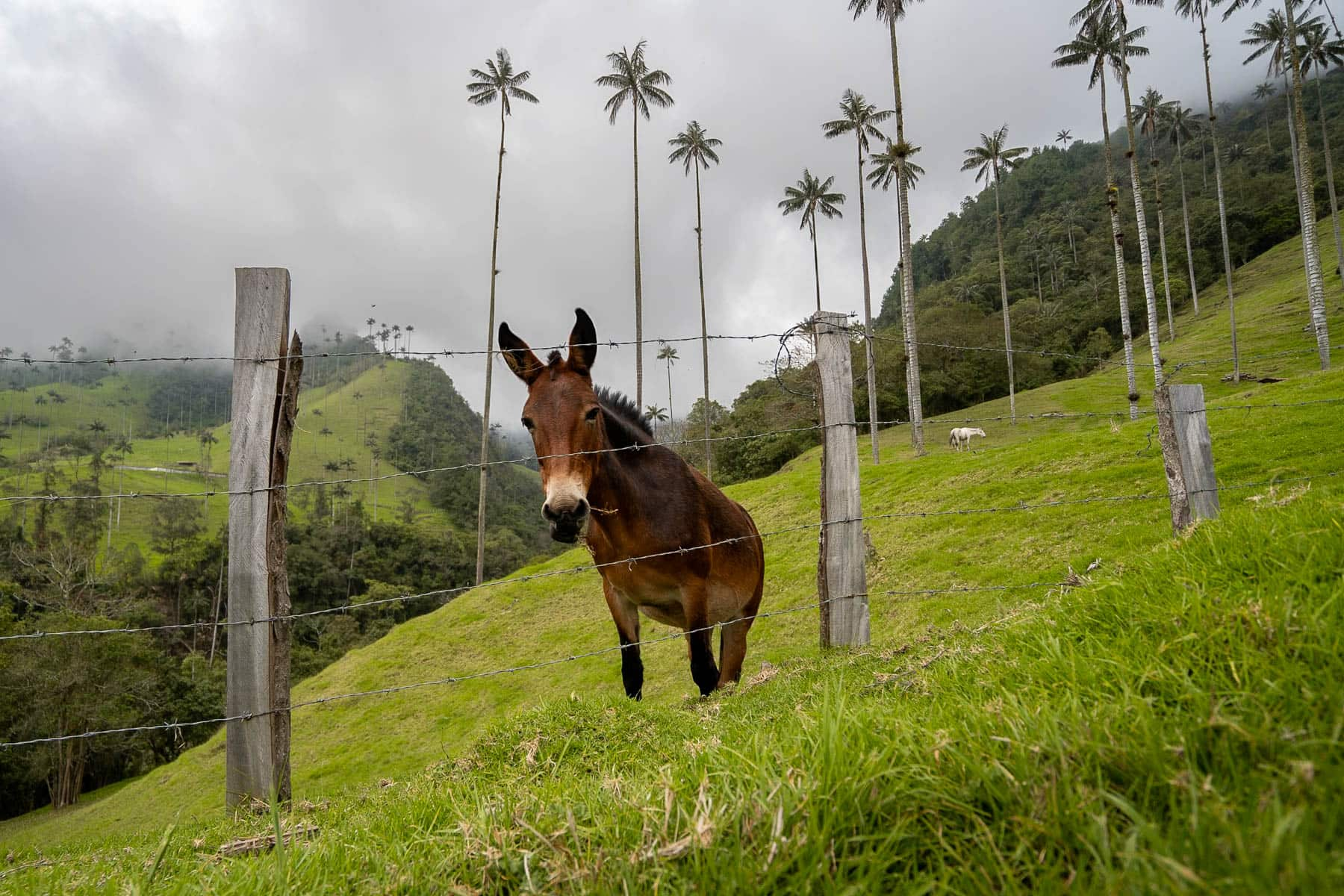
Additionally, there’s a completely separate hike called the Cerro Morrogacho, which is a challenging out-and-back trail through the cloud forest and farmland to one of the tallest summits in the region. You’ll get to see the wax palm trees off in the distance with this route, but it doesn’t directly go through El Bosque de Las Palmas.
Sounds confusing? Let’s dive into all of these options.
Shorter out-and-back Cocora Valley hike
- Length: 2.6 miles (4.2 km)
- Elevation gain: 941 feet (286 m)
- Difficulty: Easy to moderate
- Trail map
- Cost: COP 25,000 (or around $6 USD per person)
The easiest option is a short trail, which covers the northwestern section of the Cocora Valley hike through the heart of the wax palm tree forest.
In order to get to this trailhead for this hike, you’ll walk up the road from where the Willys drop you off (more on that in the How to get to the Cocora Valley section below) and see this junction.
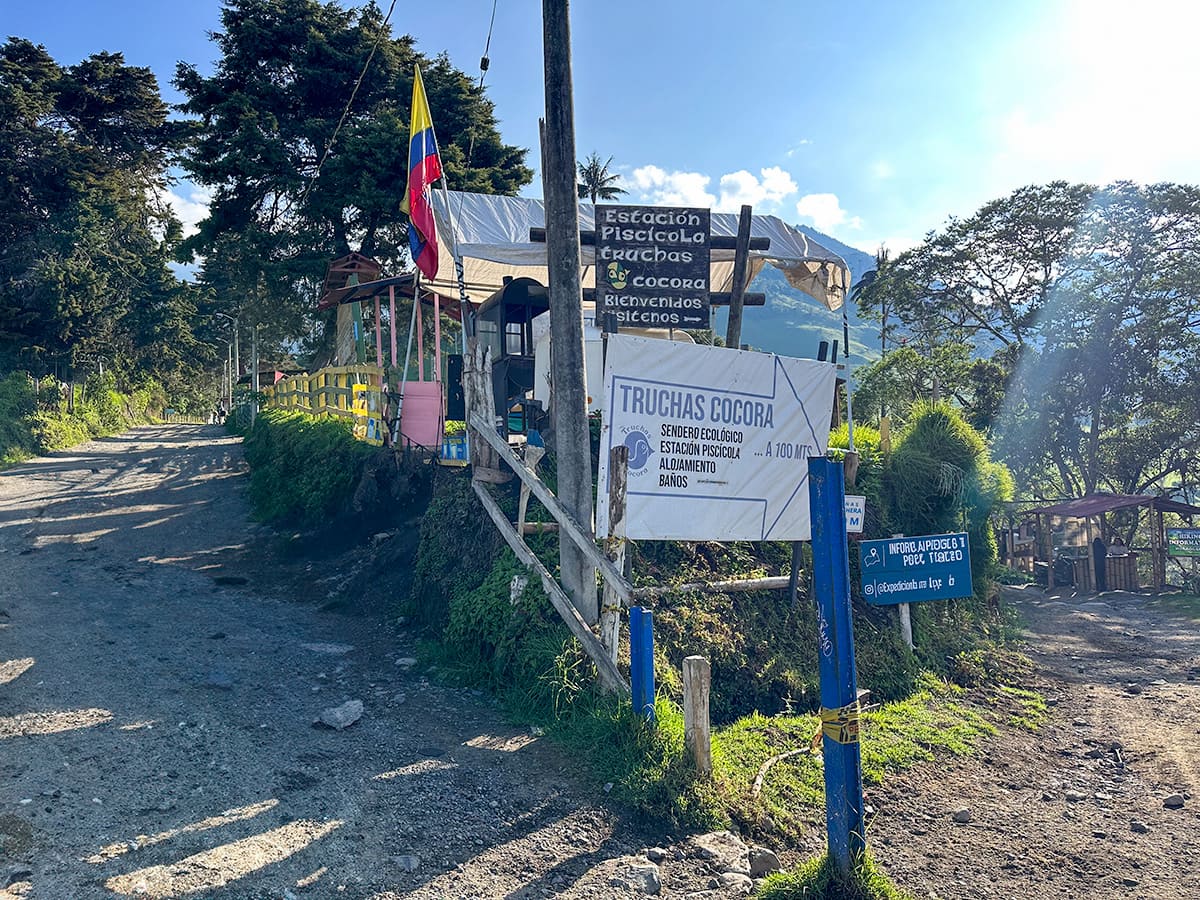
There’s usually an attendant standing there, who will tell you to go to the right if you want to do the longer hike or to continue on to the left if you want to do the shorter option. Even if there isn’t an attendant here, continue on to the left hand side.
You’ll continue walking for about 10-15 minutes along the road, until you’ll see signs for the Bosque de La Palmas. This is where you’ll stop and pay your entrance fee.
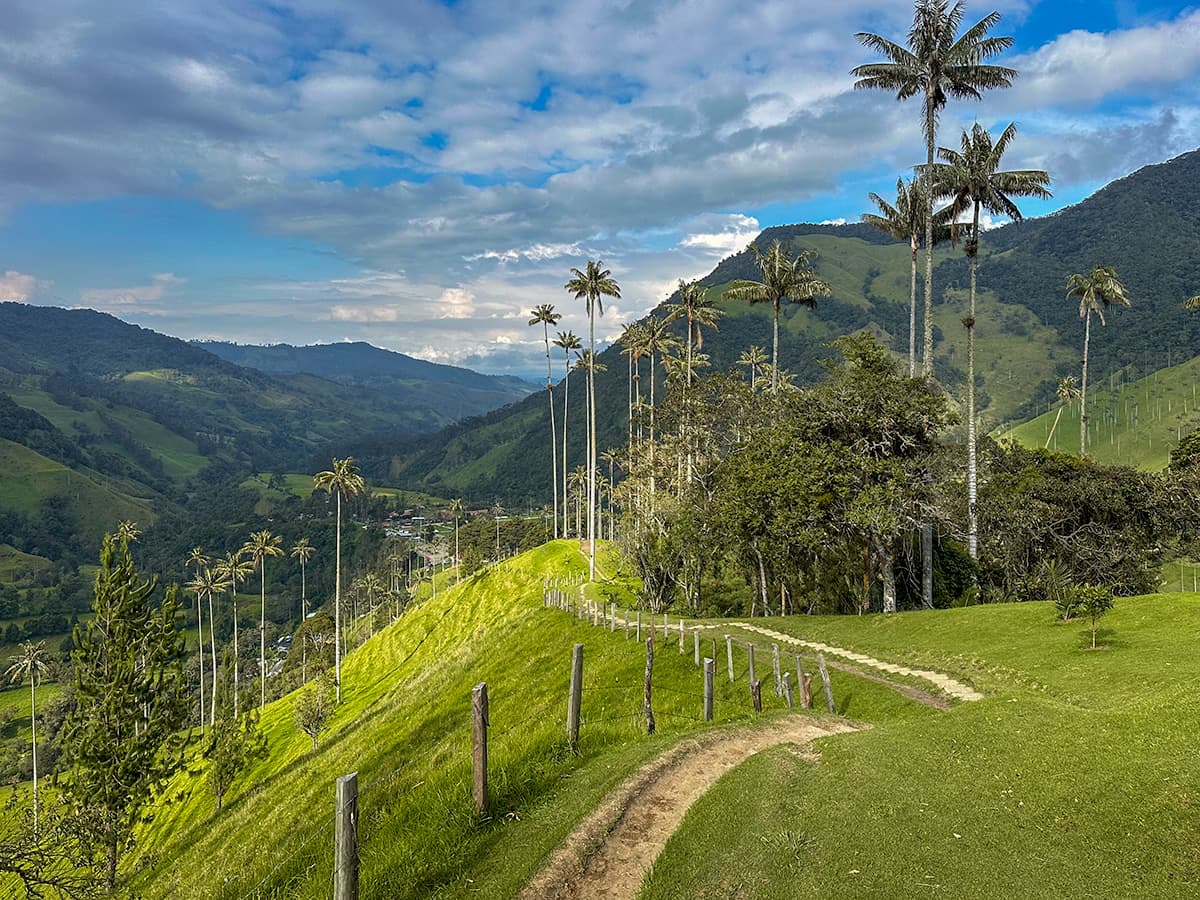
From here, the dirt path snakes through a grove of hundreds of wax palm trees, dotting the surrounding hills and farmland.
You’ll climb uphill to two different viewpoints, Mirador 1 and 2, with stunning views overlooking the surrounding valley. When you’re done taking in the views here, you climb back downhill, following a path from the Mirador 1 that loops back to the trailhead. The trail is not well-signed, so I found this aspect pretty confusing—but the map below, which you’ll find at the trailhead, is definitely helpful.
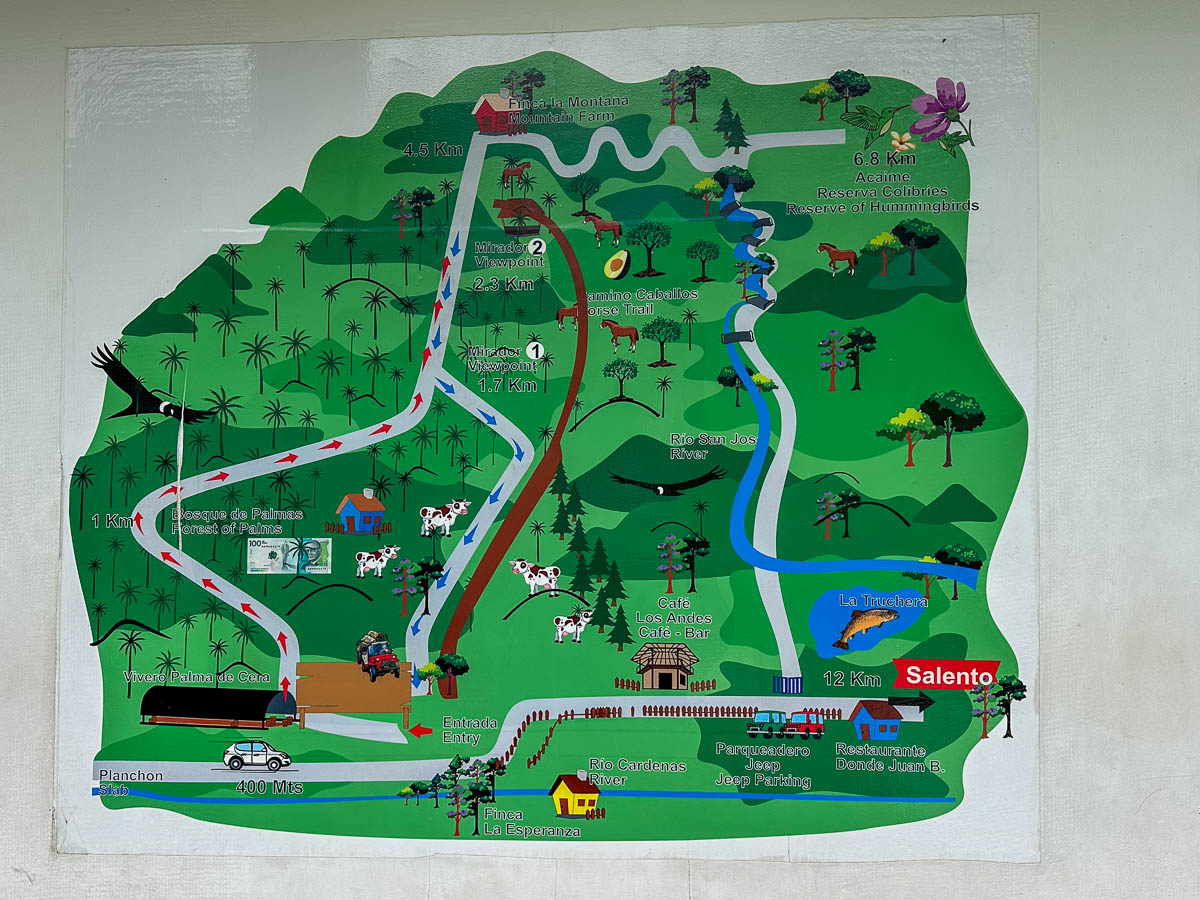
I always hear this trail being referred to as easy, but, to be honest, there’s definitely portions of the path that are on the steeper side. Still, there’s nothing technically challenging about the hike and, given how short it is, most travelers in moderate shape should be able to complete this portion of the hike.
Longer Cocora Valley loop hike
- Length: 6.8 miles (11 km)
- Elevation gain: 2,572 feet (784 m)
- Difficulty: Hard
- Trail map
- Cost: COP 25,000 entrance fee, plus an additional COP 8,000 to pass through private property (or around $7.75 USD), plus an additional COP 20,000 if you want to visit the Acaime Hummingbird Reserve—cash only
The most popular option for the Cocora Valley hike is to walk along the entire loop trail, which, in addition to the wax palms, also winds through a lush cloud forest and farmlands.
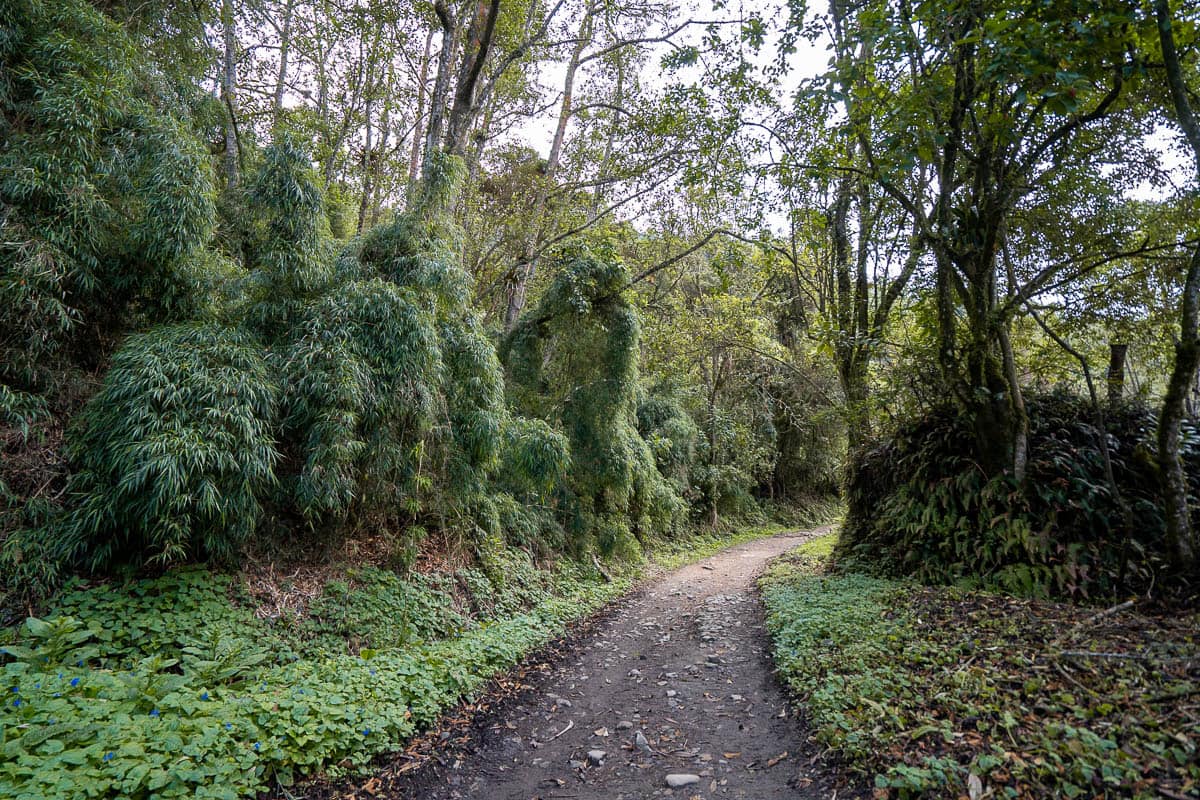
You can hike the trail clockwise, where you’d leave from the same trailhead as the shorter out-and-back trail above, hitting the wax palm tree forest first; climbing up to the tallest point along the trail, at the farm Finca La Montaña; and then down through the lush jungle.
Alternatively, you can hike the trail counter-clockwise. To reach the trailhead for this route, you’ll walk uphill from where the Willys drop you off, but choose to head to the right at the junction, described in the section above, with the attendant. Once you walk a few minutes to the right, you’ll reach a stand with an attendant, where you’ll pay your admission fee.
If you go this direction, the first part of the trail is definitely steeper (and usually, way muddier), but you’ll be able to end the trail with an awesome finale—the wax palms!
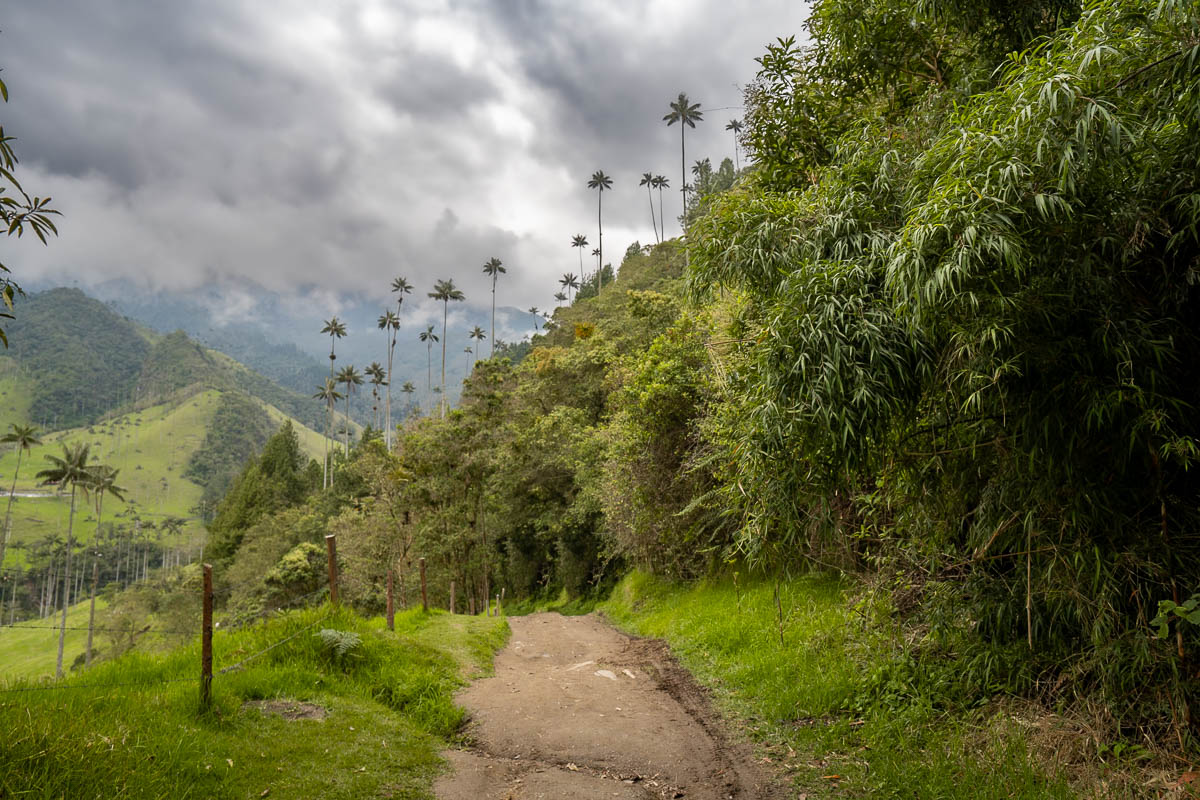
Regardless of which direction you hike it, a portion of the trail crosses onto private property, where the landowners charge an additional COP 8,000 fee.
Additionally, you’ll have the opportunity to make several stops at some of the unique features along the trail, like a snack or a cold drink at Finca La Montaña or to see some beautiful tropical birds at the Acaime Hummingbird Reserve. Note if you opt to skip this reserve, it will shave off about 4 kilometers of your hike—but if you have the time, it’s absolutely worth it!
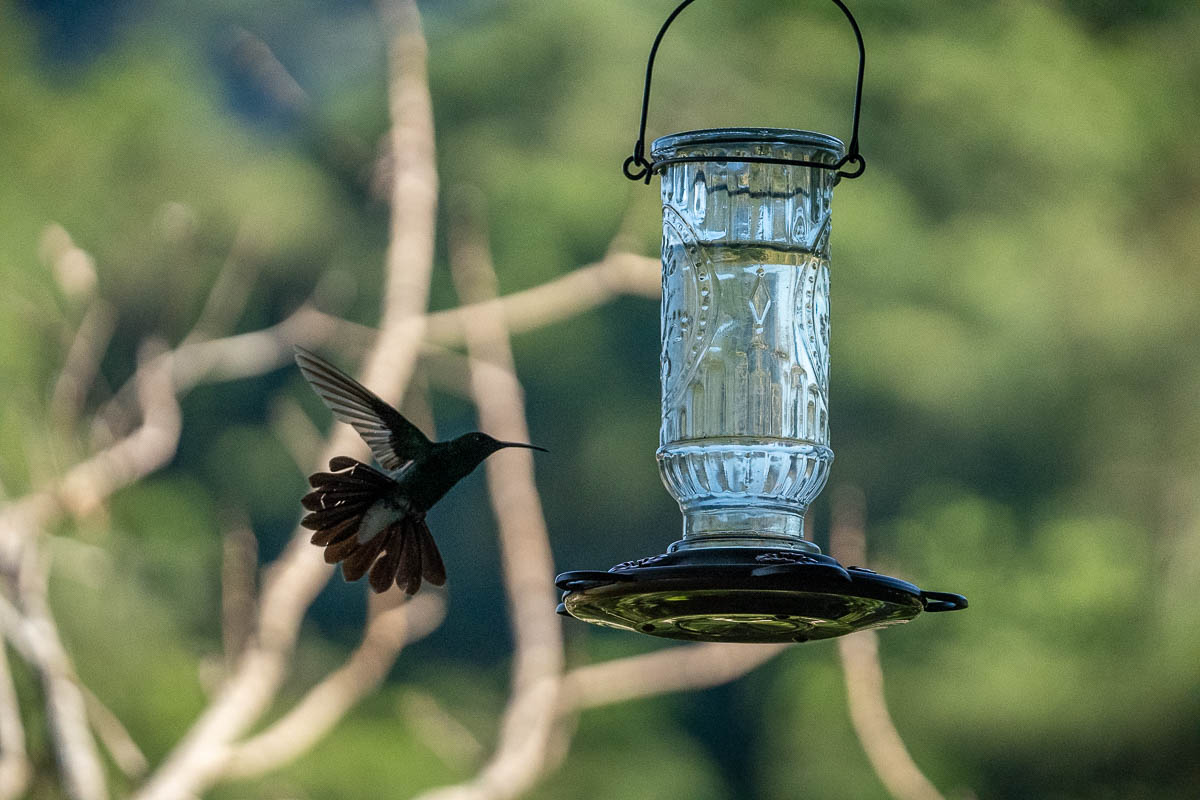
When planning our trip to the Cocora Valley, we had originally planned to hike this longer loop trail, counter-clockwise.
However, when we reached the entrance fee stand, the attendant there told us that a portion of the trail crosses into private property and is technically illegal, resulting in the landowners getting upset and chasing hikers off their property. When we asked whether the police were ever called on visitors hiking this route, she indicated they sometimes were, but didn’t offer much information beyond that.
Ultimately, we decided that hiking the loop wasn’t personally worth the risk of being chased down by an angry farmer or getting thrown in a Colombian prison, so we chose to hike another trail instead (more on that later!).
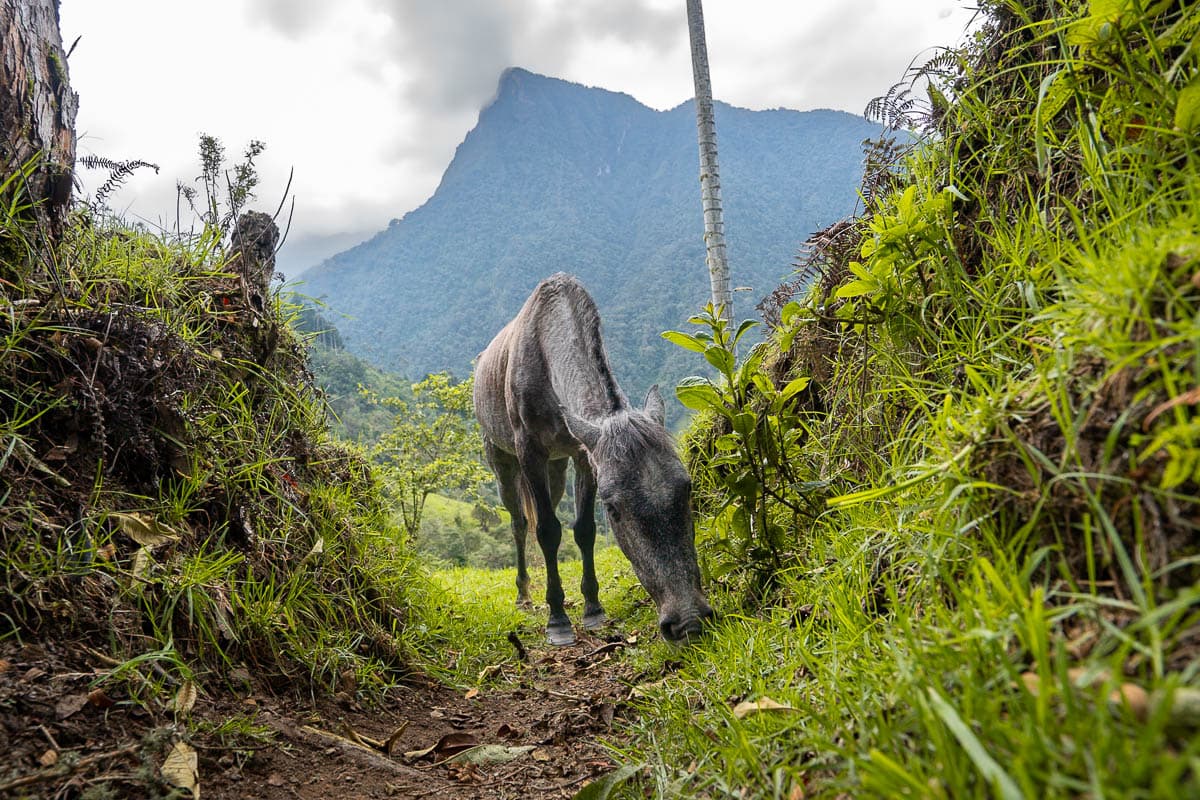
In researching this article, I haven’t been able to find anything online that validates the attendant’s assertion that a portion of the trail is illegal or that the cops are ever called on any of the hundreds of tourists that hike here every day. So I’m honestly still not sure whether what she said is accurate, whether she was misinformed, or whether she was telling us that in hopes that we’d pay to hike on the other trail in the area. Either way, we still thought it would be worth sharing our experience, though!
Cerro Morrogacho
- Length: 7.5 miles
- Elevation gain: 2,572 feet
- Difficulty: Challenging
- Trail map
- Cost: COP 20,000—cash only
This trail is totally different from the Cocora Valley loop.
However, it shares a trailhead and entrance fee station with the counter-clockwise route of the Cocora Valley loop. Accordingly, this was the fee station that we encountered when we were told by the attendant that the loop was illegal—and, since we didn’t want to mess around with potentially doing something illegal, we chose to hike the Cerro Morrogacho trail instead.
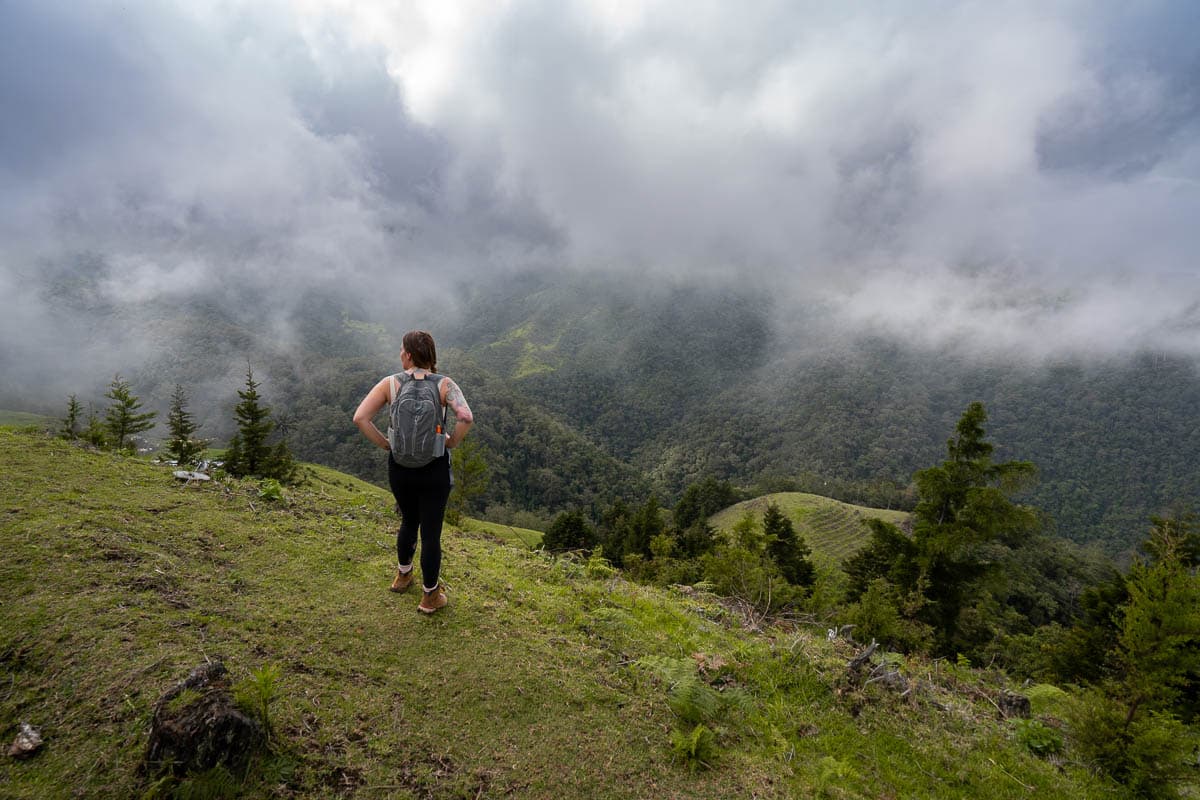
This trail is quite challenging, climbing through the rolling pastures of farmland and up to a cloud forest at the summit of one of the Andes Mountains. Besides the trail’s steepness, the trail also climbs to high elevations—11,400 feet above sea level, at its tallest point. Because the air is thinner here, it makes climbing that much more challenging—I’ve even read reports of people struggling with altitude sickness here.
While the trail is quite the butt-kicker, it also offers absolutely stunning views of the surrounding lush hills, with lots of cute cows, horses, and mules along the way. However, this really isn’t a good option if your main priority is to see the wax palms in the Cocora Valley, as there’s only a handful of them, sprinkled throughout the rolling hillside at lower elevations, and way off in the distance. We didn’t realize that until we were basically already at the summit of the trail—so, hopefully, we can save you some thigh-burning!
Tips for the Cocora Valley Hike
Wear waterproof hiking boots or rent rainboots
Before heading to the Cocora Valley, I had heard that this trail was muddy, but, y’all, I was NOT prepared for the level of mud that we encountered here, especially along the Cerro Maragacho trail.
Salento is located in a pretty rainy area—we were told by locals that it had rained every day for a month straight before we got there! So I would generally recommend going into this hike prepared to deal with an insane amount of mud as well.
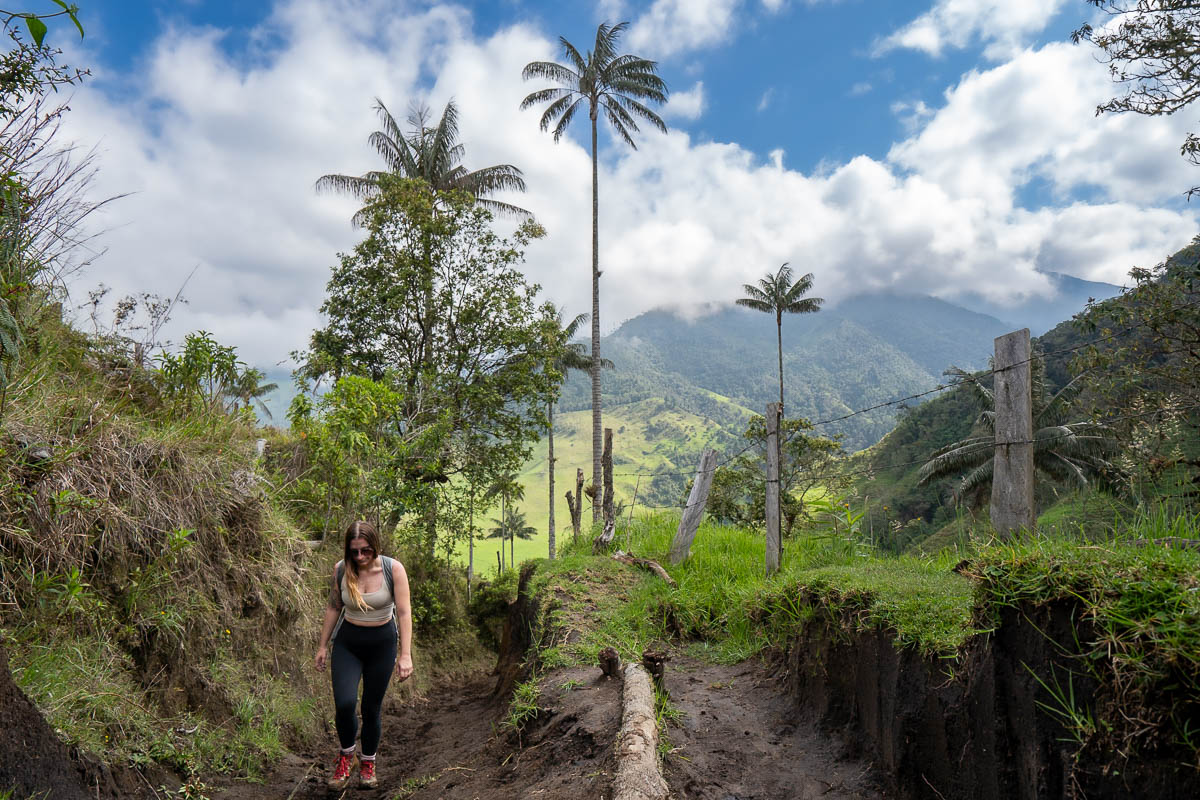
I’d highly recommend wearing waterproof hiking boots that offer additional traction on steep and slippery surfaces—I’ve used and loved these boots for years and Justin has these.
In a pinch, most hostels in Salento and the trailhead itself rent rainboots—but I would really only use them if you don’t have hiking boots. They’re not very comfortable, will probably rub your ankles raw if hiking, and don’t provide support for a pretty lengthy trail.
Bring bug spray
A significant portion of the Cocora Valley hike is through the cloud forest and jungle—so, of course, you’re going to encounter some mosquitoes!
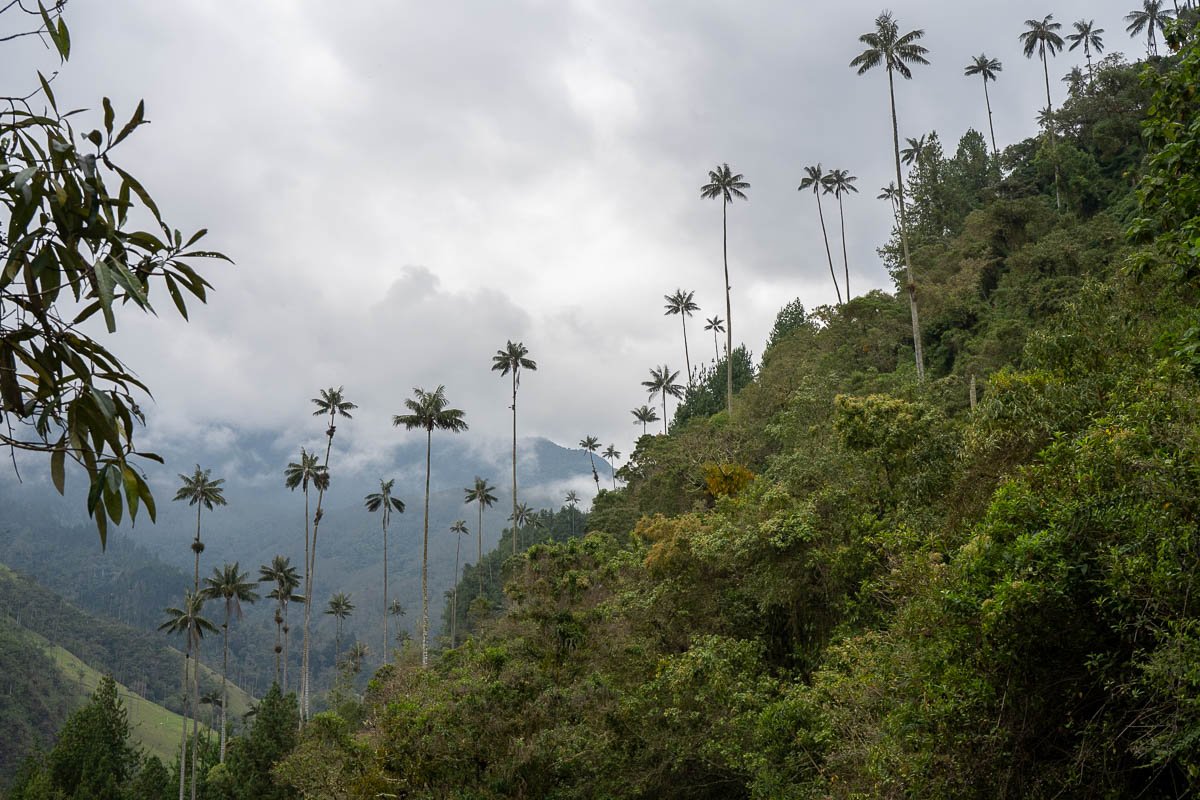
Come armed with bug spray and keep those blood suckers at bay.
Bring water and sunscreen
If you’re hiking the full loop trail, it’s a pretty lengthy hike, taking most visitors between 5-7 hours to complete. So be sure to bring sufficient snacks and water (we always hike with these enormous Nalgene bottles and LOVE them!). There’s one snack/drink stand along the way at Finca La Montaña and a handful of snack stands by the trailhead, but, generally, you’ll be on your own!
And, despite the Cocora Valley generally having cooler temperatures and moodier clouds than most of Colombia, you’ll still likely encounter quite a bit of sun on the trail. Plus, because of the Cocora Valley’s relatively high altitude, the UV rays can be kind of intense here. So be sure to bring along and use plenty of sunscreen!
Bring cash
We were actually surprised how many business in Colombia accepted credit cards, but the Cocora Valley was not one of them. You’ll need pesos for your transportation to the Cocora Valley, your entrance fee, and any food and drinks you want to pick up there.
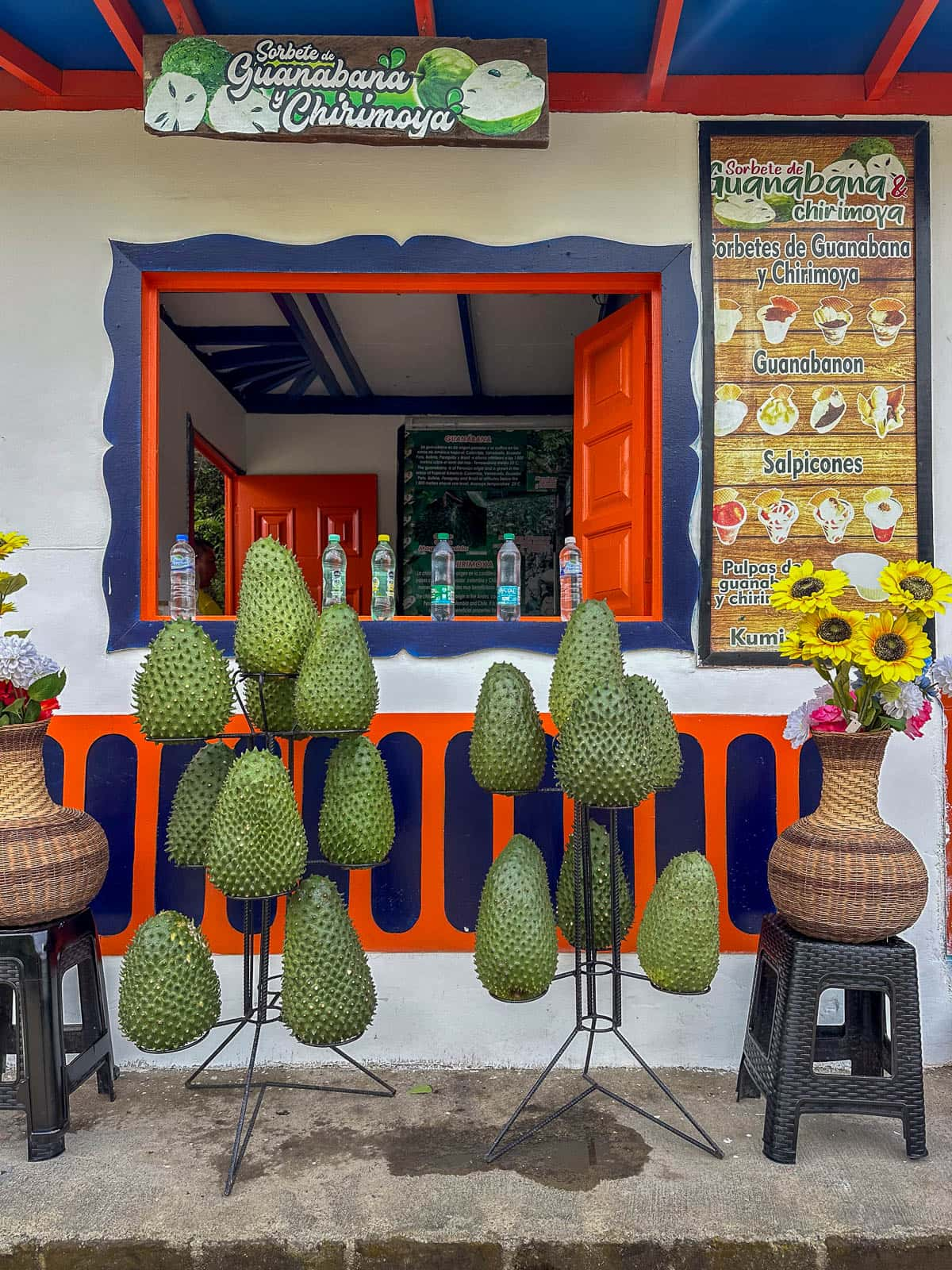
On that note, PLEASE stop at the stand that sells sorbetes de guanabana y chirimoya. I’m still dreaming about it!
How to get to the Cocora Valley
The Cocora Valley is located about a 25 minute drive east of the small town of Salento, in Central Colombia.
There’s tons of awesome things to do in Salento, from the Cocora Valley and coffee farms to playing tejo, a traditional Colombian game that literally involves explosives—so we’d definitely recommend including it during your time in the country!
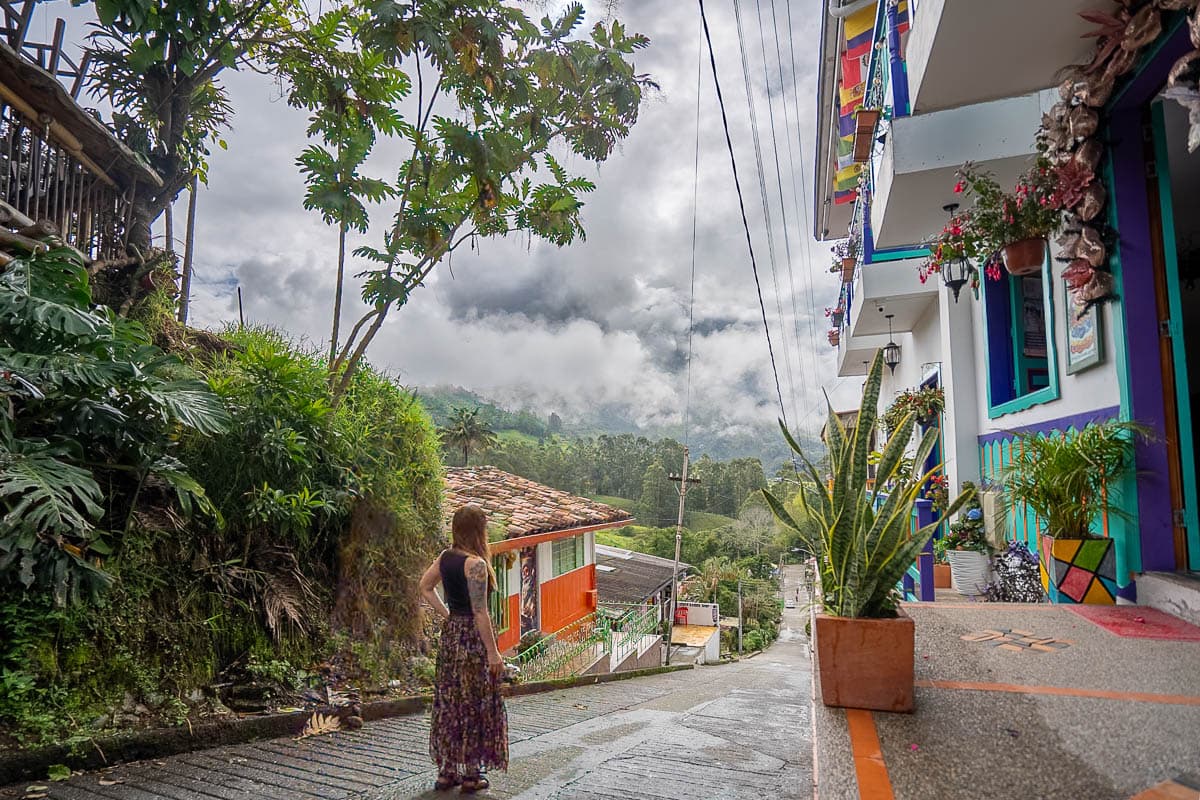
How to get to Salento
You have a few options of getting to Salento, whether you’re coming from another city in Colombia or if Salento is your first stop in the country.
Getting to Salento by bus
It’s really easy and affordable to get to Salento by bus from most of the other major cities in central Colombia, like Medellin, Bogota, or Cali. In fact, one of Justin’s and my favorite things about Colombia is how easy (and cheap!) it is to get around the country by bus!
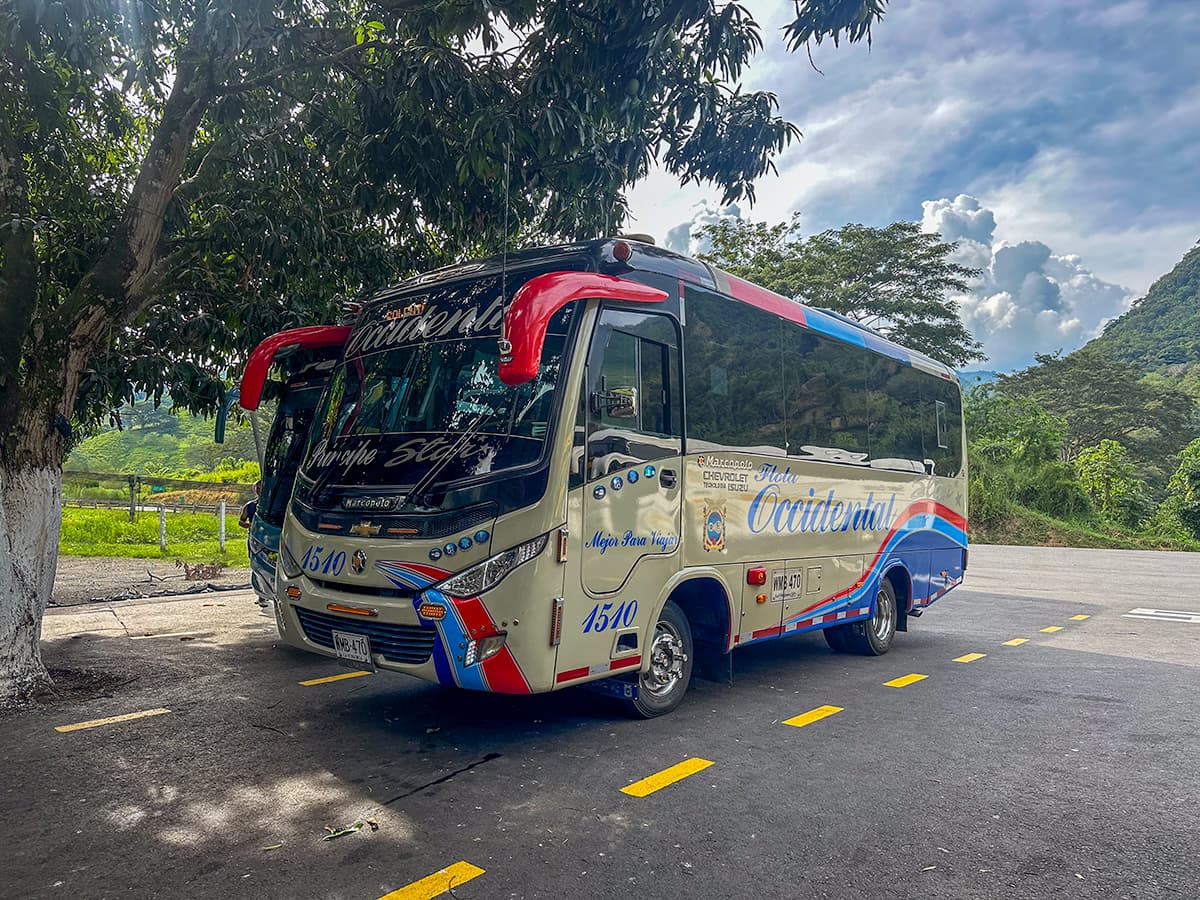
Here’s some options you can consider:
Because of Salento’s location, tucked high in the Andes Mountains, the route to get there from other cities is often along windy mountain roads and can be on the longer side (i.e., 4 hours for Cali or around seven hours for Medellin or Bogota).
We had heard from other travelers that the bus ride there was dizzying and vomit-inducing. However, when we rode from Medellin to Salento, that wasn’t our experience at all—and Justin is actually prone to motion sickness! In any event, if you’re sensitive to motion sickness, you may want to consider taking some preventative medicine beforehand!
Getting to Salento by plane
If you’re short on time or are coming from a city that’s further away, your best bet is to fly into the nearby city of Pereira, which has an international airport.
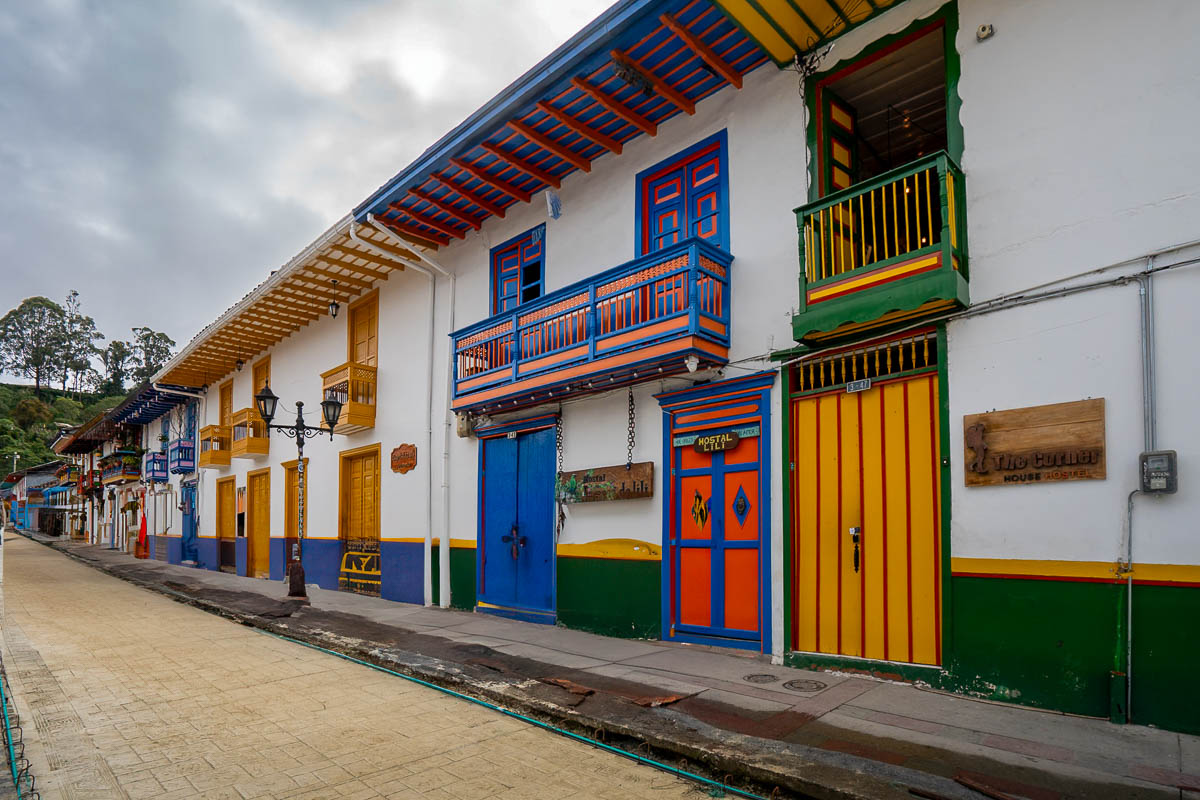
From here, you can hire a shuttle to pick you up from the airport, which will take you directly to your accommodations in Salento. Alternatively, you can grab a taxi or Uber to the bus station and take an hour-long bus ride to Salento.
How to get from Salento to the Cocora Valley
From the town of Salento, it’s quite easy—and actually, kind of fun!—to get to the Cocora Valley.
Head to the Plaza de Bolivar, the main square in Salento, where you’ll find the Willy terminal on its southeastern side. Here, there’s a small kiosk where you can buy a roundtrip ticket for a Willy to the Cocora Valley for COP 10,000 per person (cash only!).
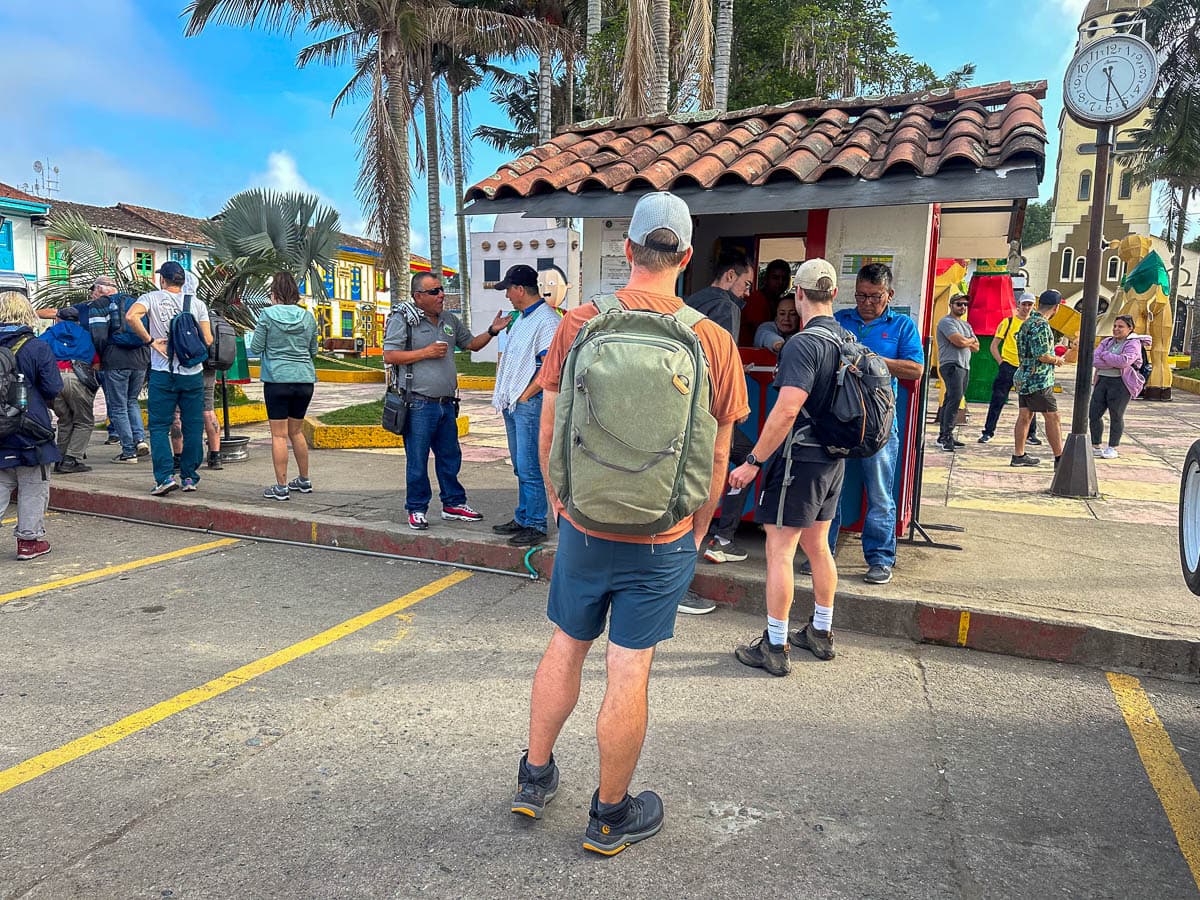
So, what exactly is a Willy? I’m so glad you asked!
A Willy is effectively a vintage Jeep that’s been retrofitted to have two benches in its back. Depending on how tightly the passengers squeeze in—and how many hang onto the bumper(!!), you can fit up to 15 passengers. Try to snag a seat in the back—the views once you get into the valley are absolutely stunning!
The first Willy leaves Salento around 6:30 AM, with the last Willy returning from the Cocora Valley around 6 or 6:30 PM. We were initially told that Willys leave every half hour, but this seems pretty inconsistent—sometimes, there seemed to be a huge crowd of passengers waiting for Willys for well over half an hour and other times where the Willys left as soon as they were full.
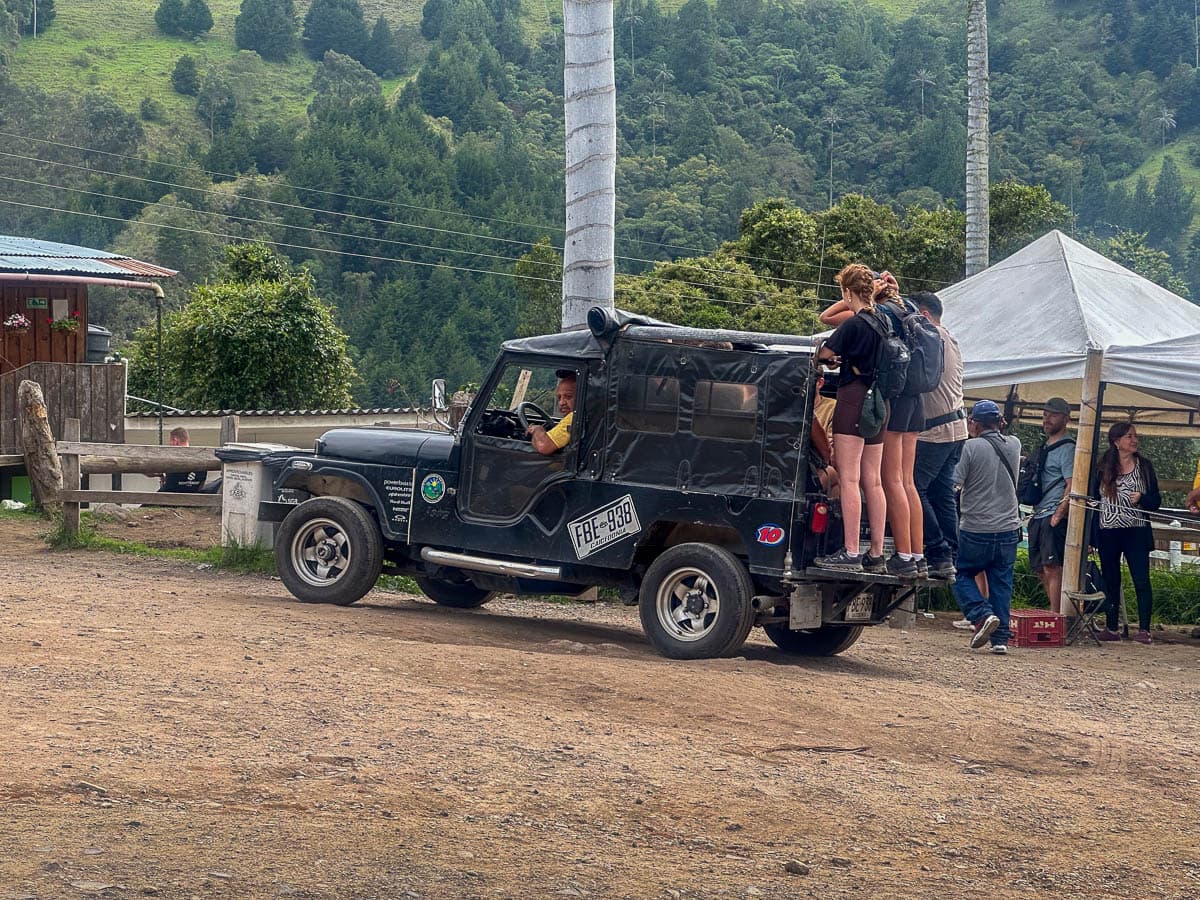
In any event, be prepared to be patient and flexible!
Alternatively, there’s also plenty of tours that head from Salento to the Cocora Valley, like this group tour or this private option.
In full transparency, it’s pretty straightforward to get to and around the Cocora Valley yourself, so I definitely don’t think you need a tour. However, if you prefer guided experiences to learn more about the ecology or history of the area or simply don’t want to mess around with Willys, going on a tour might be a great option.
When to Visit the Cocora Valley
The Cocora Valley is known for its lush green hills and low-hanging clouds—so it’s no surprise that Salento is known for being on the rainier side!
If you want to avoid the rain and mud, the driest months are December through March. That being said, even those can be a bit on the wetter side—we visited in December and it still rained four out of the seven days that we were there.
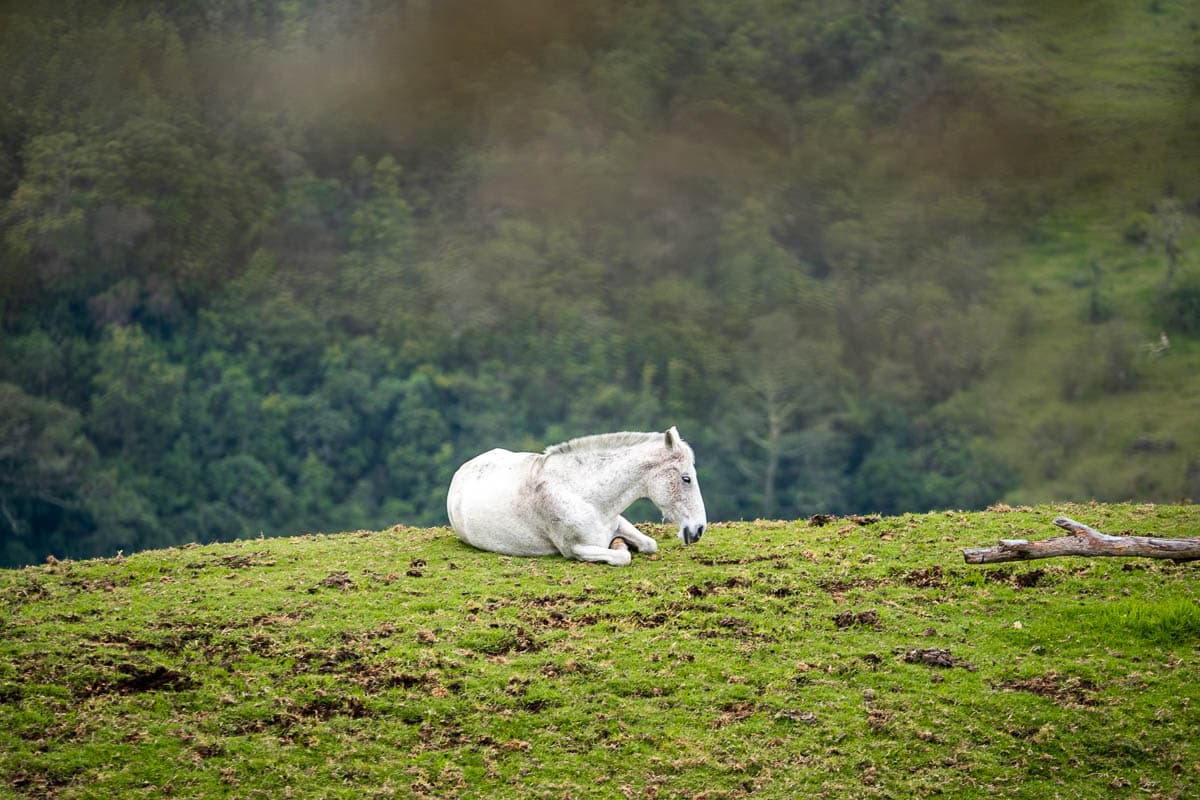
In terms of the time of day, I’d suggest heading to the Cocora Valley as early as you can. Not only will you beat the crowds, but you’re more likely to miss the clouds and rainstorms that frequently roll in every afternoon.
In any event, regardless if you’re coming during the wet or “dry” season, I’d recommend bringing along waterproof boots, a rain jacket (here’s my rain jacket and this is the one Justin uses), and a positive attitude!
Where to stay near the Cocora Valley
There’s a handful of hotels within walking distance to the Cocora Valley, but, to be honest, I wouldn’t recommend staying at these properties—most of them are on the more basic side and are quite isolated from stores and restaurants.
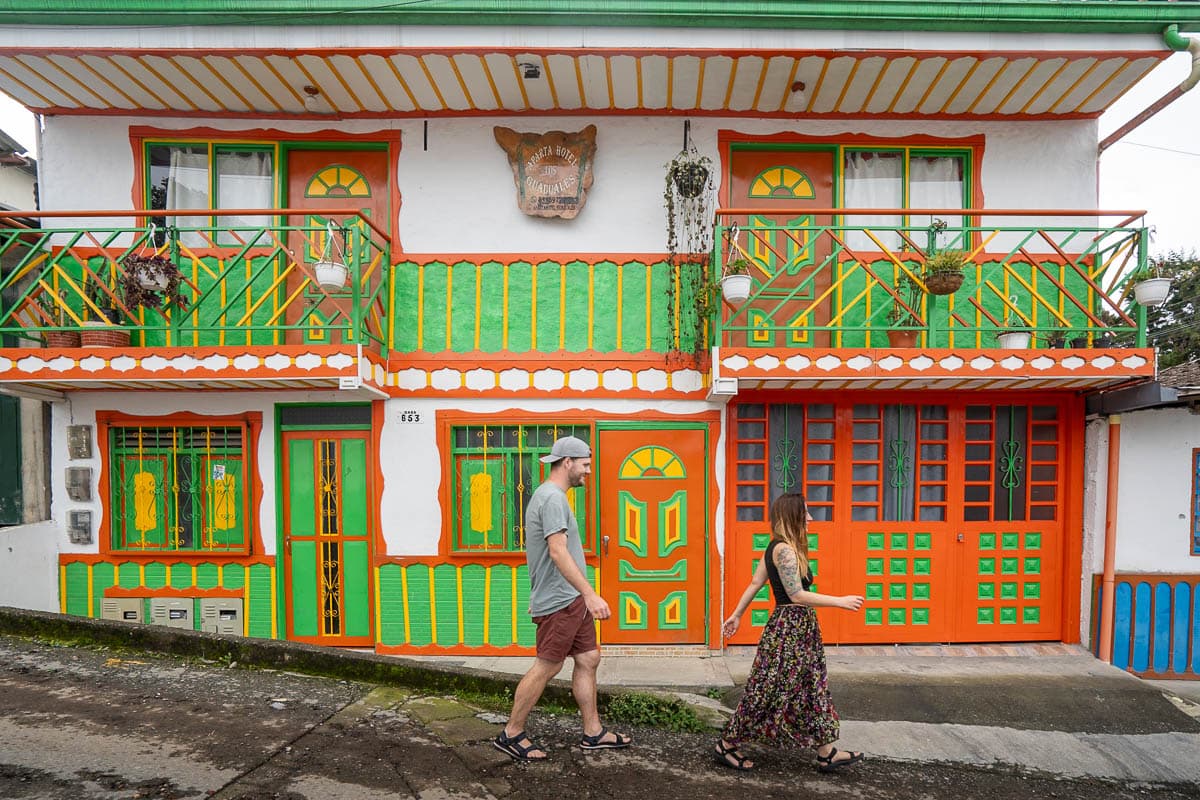
Instead, I’d recommend staying in the colorful and adorable town of Salento, which has tons of options of where to stay, plus is just a quick Willy ride away from the Cocora Valley.
Some of our favorite places to stay in Salento are:
- Beta Hotel: This hotel has everything you need in a home-away-from-home in Salento, including complimentary breakfast, an onsite restaurant, and SUPER comfy beds. Plus, the staff really go above and beyond to make sure you have the best time in Salento, from printing out your bus tickets to helping you get to the coffee farms that surround the town.
- Hotel Salento Real: This property is located in the heart of Salento, while still offering a quiet respite after your hiking adventures. Plus, its rooms are spacious and comfortable and I’d argue that the complimentary breakfast here is one of the best in Salento!
- Casa Borbon: If you’re looking for a room with a view, Casa Borbon is your place, offering rooms with adorable balconies that overlook the surrounding mountains. Beyond that, though, the rooms and property are kept immaculately clean and well-maintained and the friendly staff are keen to help you make the most of your time in Salento.
Enjoy hiking through the Cocora Valley—it’s such a magical place! Do you have any questions about the Cocora Valley? Let us know in the comments below!

